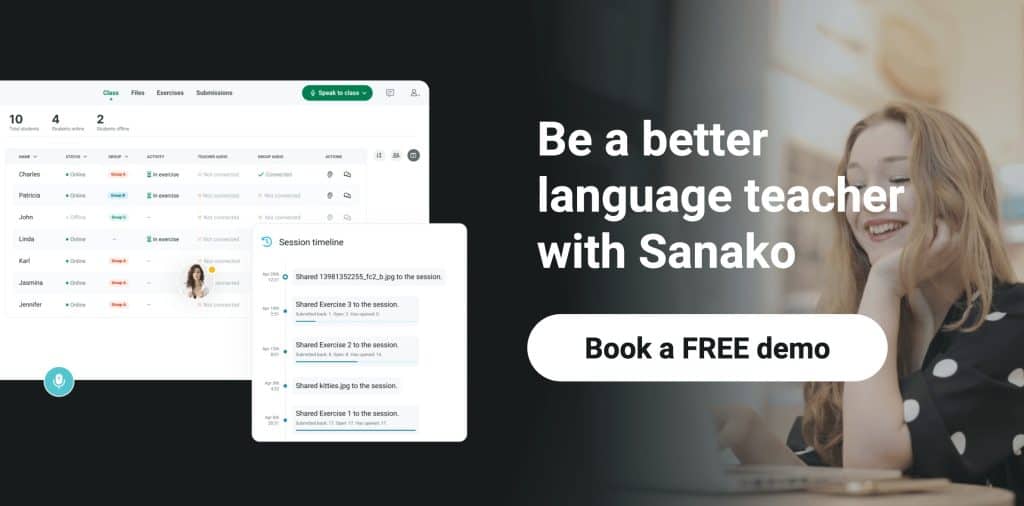Writing a lesson plan for each class they’ll teach should be a key part of an educator’s daily preparation. The lesson plan is the roadmap that the teacher will follow to help make her lesson successful and to produce the desired learning outcomes. Because it is critical for success to have a good plan for your language lessons, we at Sanako thought that we’d try and pull together a definitive (hopefully!) blog post on how to create the perfect lesson plan for language classes!
What is a lesson plan?
If you’re starting out on your journey as a language educator or have never used a lesson plan before, it may be helpful to start by looking at the two component parts – lesson and plan.
According to Brown (2001), a lesson is defined as “a unified set of activities that cover a period of classroom time… These classroom time units are administratively significant for teachers because they represent steps along a curriculum before which and after which you have a hiatus (of a day or more) in which to evaluate.”
Of course, plan is a word that we’re all familiar with. Although it can be used in different ways, it most commonly refers to “a set of things to do in order to achieve something, especially one that has been considered in detail in advance” (Oxford). Evidently, all successful plans have a start and end point as well as some sense of the journey between the two.
Effective lesson planning is the process of selecting and organising a complementary set of activities to engage students during a period of classroom time. Jeremy Harmer (2001) goes further: lesson planning “is the art of combining a number of different elements into a coherent whole so that a lesson has an identity.”
What are the components of an effective lesson plan?
Our ambition in this post is not to provide a lesson plan template – after all, what’s right for one teaching context may not be right for another. Rather, our aim is to provide an outline of the universal elements that should be included, as well as highlighting some of the key things to consider when putting a lesson plan together.
1. Aims and objectives
Each lesson plan must have a clear focus that identifies its key learning objectives. What will all / some learners be able to do at the end of the lesson that they couldn’t do before? And always think about why students are doing a particular learning activity. If there’s no direct educational impact and it doesn’t support your lesson objectives, remove it from your plan.
2. Lesson activities
Consider the broad learning activities that students will undertake in the class and the specific skills sets that will be developed. As always, select the approach and language teaching methods that best suit your class and your lesson objectives. Don’t forget to include time for reflection / evaluation and consider how the lesson could be extended through homework or extension projects.
3. Step-by-step procedures
Having identified the different activities, this stage moves into specific detail. Carefully think through how you will actually deliver the activity in the classroom and how all students will be able to engage and benefit. Be clear about the language outputs – is it a presentation, a podcast or a TikTok? Be sure to include opportunities for assessment.
4. Interaction formats
A key part of this will be to think about the types of interaction that will occur between students. Is the proposed writing task an individual one? Will students do the speaking task in pairs or in groups? And if students are in groups / pairs, who will be working together? The more you can plan in advance, the better. It all helps to keep the class focused and reiterates who’s in control.
5. Timing
Of course, all of the above elements need to be carefully scheduled to fit into the available time. Be realistic about how much can be achieved; try to stick to the timings that you put in place but always try to be flexible!
6. Lesson materials
Language teaching activities usually require some form of stimulus material and it’s important to be clear what you’ll need to prepare or book in advance. This could include textbooks, audio files, videos, authentic local magazines or perhaps even a native speaker or two! Take the time to plan what you need and make sure you have everything ready for when the lesson begins. Leaving the class unattended to do some last-minute photocopying isn’t a great look!
7. Aids and support
Equally, think about whether you need any kit to deliver your lesson as planned. Do you need to book a class set of laptops? Does every student have / need headphones? And of course, check that the kit works and that you have passwords to hand so that time isn’t wasted during the lesson. Of course, you might also have some human support in your lesson, so be sure to think about how to use a teaching assistant most impactfully.
Don’t forget to take into account individual student’s needs
Before starting on your lesson plan, it is vital to identify and understand the needs of your students and the broader class profile. This helps direct your teaching towards learners’ strengths and gives students personal focus and guidance. This should underpin everything that goes into your language lesson plans – otherwise you’ll end up with a class of unmotivated and uninspired learners.
Similarly, it’s important to ensure that the planned learning activities and tasks include topics and resources that are relevant, meaningful and interesting to your learners. They should also include a coherent combination of the core language skills as well as providing a variety of different ways for learners to express themselves and to creatively engage in the lesson content. The more opportunities that learners have to actively practise their target language, the more confidence and fluency they will develop.
Be flexible
For many teachers, preparing a lesson plan is a good way to build their confidence and to reduce uncertainty in the classroom. A good plan can certainly help to predict possible problems and prepare possible solutions. But it’s not a 100% guarantee that things will go as planned.
Sometimes things just happen that could not have been predicted – there’s a fire drill, the internet is down, your teaching assistant is ill, your guest speaker gets stuck in traffic. The list is endless, but it’s vital to be flexible and think on your feet. If possible, consider these eventualities in advance and include some standby solutions such as backup learning activities on your plan.
Writing in 2001, Harmer has a more positive spin: “…plans – which help teachers identify aims and anticipate potential problems – are proposals for action rather than scripts to be followed slavishly.” The very best language educators will therefore be carefully attuned to the reaction of their students and will adjust their lesson plan accordingly. If students are really engaged in a particular language learning activity, try to find a way to extend it and shuffle timings around. Why not try to exploit the unexpected learning opportunities as they arise! Writing get well soon cards to the poorly TA or offering alternative directions / travel routes to the stranded class guest are two simple responses.
If you are interested in learning more about how Sanako’s language teaching software supports language teachers and students and would like to see how it could benefit your institution, book a FREE remote demo now to see it in action.

